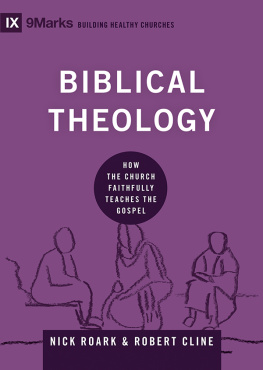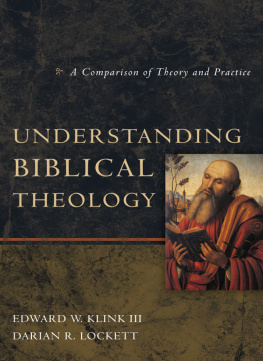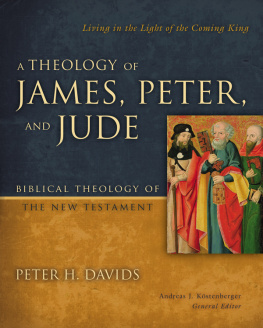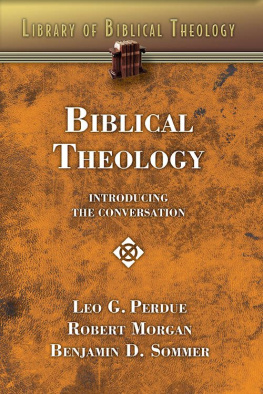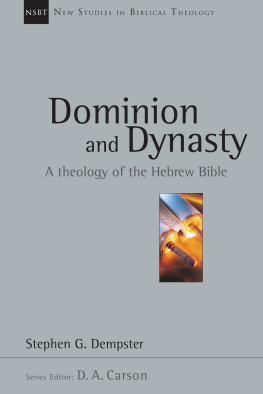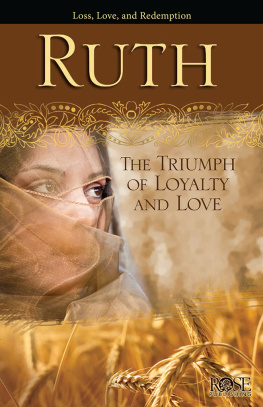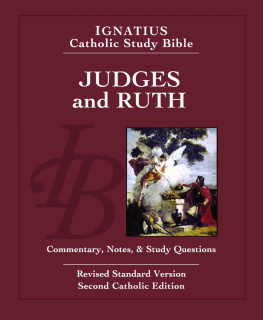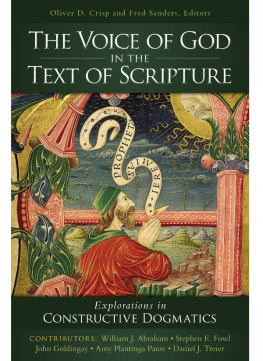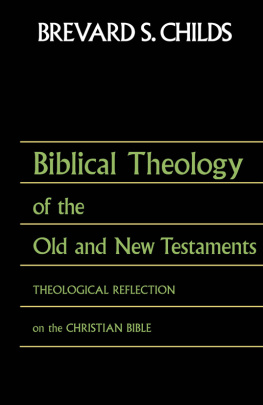Ackerman, S. (1998), Warrior, Dancer, Seductress, Queen: Women in Judges and Biblical Israel , The Anchor Bible Reference Library, New York: Doubleday.
Ackroyd, P. R. (1976), God and People in the Chroniclers Presentation of Ezra, in J. Coppens (ed.), La Notion biblique de Dieu , BETL 41, Leuven: Leuven University Press, 45162.
Adams, S. L. (2014), Social and Economic Life in Second Temple Judea , Louisville: Westminster John Knox.
Alexander, T. D. (1997), Further Observations on the Term Seed in Genesis, TynB 48: 363367.
___ (1998a), Royal Expectations in Genesis to Kings: Their Importance for Biblical Theology, TynB 49: 191212.
___ (1998b), The Servant King: The Bibles Portrait of the Messiah , Leicester: Inter-Varsity Press.
Allen, L. C. (2002), Psalms 101150 , WBC 21, Nashville: Thomas Nelson.
Amit, Y. (1994), Literature in the Service of Politics: Studies in Judges 1921, in H. G. Reventlow, Y. Hoffman and B. Uffenheimer (eds.), Politics and Theopolitics in the Bible and Postbiblical Literature , JSOTSup 171, Sheffield: Sheffield Academic Press, 2840.
___ (2000), Hidden Polemic in Biblical Literature , tr. Jonathan Chipman, Biblical Interpretation Series 25, Leiden: Brill.
___ (2009), The Book of Judges: Dating and Meaning, in G. Galil, M. Geller and A. Millard (eds.), Homeland and Exile: Biblical and Ancient Near Eastern Studies in Honour of Bustenay Oded , VTSup 130, Leiden: Brill, 297322.
Andersen, F. I. (1986), Yahweh, the Kind and Sensitive God, in P. T. OBrien and D. G. Peterson (eds.), God Who Is Rich in Mercy: Essays Presented to Dr. D. B. Knox , Homebush West, NSW: Lancer Books, 4188.
Andersen, F. I., and D. N. Freedman (1989), Amos , New York: Doubleday.
Anderson, B. W. (1950), The Place of the Book of Esther in the Christian Bible, JR 30: 3243.
Bailey, K. E. (2008), Jesus through Middle Eastern Eyes: Cultural Studies in the Gospels , Downers Grove: IVP Academic.
Baker, D. L. (2010), Two Testaments, One Bible: The Theological Relationship between the Old and New Testaments , Nottingham: Apollos.
Balentine, S. E. (1980), A Description of the Semantic Field of Hebrew Words for Hide, VT 30: 137153.
___ (1983), The Hidden God: The Hiding of the Face of God in the Old Testament , Oxford: Oxford University Press.
Bar-Efrat, S. (1980), Some Observations on the Analysis of Structure in Biblical Narrative, VT 30: 154173.
Barker, P. A. (2004), The Triumph of Grace in Deuteronomy: Faithless Israel, Faithful Yahweh in Deuteronomy , Paternoster Biblical Monographs, Carlisle: Paternoster.
Bartholomew, C. G., and M. W. Goheen (2004), The Drama of Scripture: Finding Our Place in the Biblical Story , Grand Rapids: Baker Academic.
Barton, J. (2007), Oracles of God: Perceptions of Ancient Prophecy in Israel after the Exile , new edn, London: Darton, Longman & Todd.
Batumalai, S. (1990), A Malaysian Theology of Muhibbah: A Theology for a Christian Witnessing in Malaysia , Kuala Lumpur: Seminari Theoloji Malaysia.
Bauckham, R. (1997), The Book of Ruth and the Possibility of a Feminist Canonical Hermeneutic, BibInt 5: 2945.
___ (2003), Bible and Mission: Christian Witness in a Postmodern World , Grand Rapids: Baker Academic.
Bauer, J. B. (1963), Das Buch Ruth in der jdischen und christlichen berlieferung, Bibel und Kirche 18: 116119.
Baylis, C. P. (2004), Naomi in the Book of Ruth in Light of the Mosaic Covenant, BibSac 161: 413431.
Beal, T. K. (1997), The Book of Hiding: Gender, Ethnicity, Annihilation, and Esther , London: Routledge.
Beale, G. K. (1984), An Exegetical and Theological Consideration of the Hardening of Pharaohs Heart in Exodus 414 and Romans 9, TrinJ 5: 129154.
___ (1998), The Book of Revelation , Grand Rapids: Eerdmans.
___ (2012), Handbook on the New Testament Use of the Old Testament , Grand Rapids: Baker Academic.
Beale, G. K., and B. L. Gladd (2014), Hidden But Now Revealed: A Biblical Theology of Mystery , Downers Grove: IVP Academic.
Beattie, D. R. G. (1977), Jewish Exegesis of the Book of Ruth , JSOTSup 2, Sheffield: JSOT Press.
___ (1994), The Targum of Ruth , Aramaic Targums 19, Edinburgh: T&T Clark.
Beckwith, R. (1985), The Old Testament Canon of the New Testament Church and Its Background in Early Judaism , Grand Rapids: Eerdmans.
___ (1991), A Modern Theory of the Old Testament Canon, VT 41: 385395.
Beekman, J., J. Callow and M. Kopesec (1981), The Semantic Structure of Written Communication , 5th rev., Dallas: SIL.
Berg, S. B. (1979), The Book of Esther: Motifs, Themes and Structure , SBLDS 44, Missoula: Scholars Press.
Berger, Y. (2009), Ruth and Inner-Biblical Allusion: The Case of 1 Samuel 25, JBL 128: 253272.
Berlin, A. (1983), Poetics and Interpretation of Biblical Narrative , Bible and Literature Series 9, Sheffield: Almond Press.
Berquist, J. L. (2008), Resistance and Accommodation in the Persian Empire, in R. A. Horsley (ed.), In the Shadow of Empire: Reclaiming the Bible as a History of Faithful Resistance , Louisville: Westminster John Knox, 4158.
Bertman, S. (1965), Symmetrical Design in the Book of Ruth, JBL 84: 165168.
Bickerman, E. (1967), Four Strange Books of the Bible: Jonah, Daniel, Koheleth, Esther , New York: Schocken Books.
Blackburn, W. R. (2012), The God Who Makes Himself Known: The Missionary Heart of the Book of Exodus , Downers Grove: InterVarsity Press
Blenkinsopp, J. (1988), EzraNehemiah: A Commentary , OTL, Philadelphia: Westminster.
Blidstein, G. J. (1974), Atimia : A Greek Parallel to Ezra x 8 and to Post-Biblical Exclusion from the Community, VT 24: 357360.
Bliese, L. F. (1988), Chiastic Structures, Peaks and Cohesion in Nehemiah 9:637, BT 39: 208215.
Block, D. I. (1997), The Book of Ezekiel: Chapters 124 , NICOT, Grand Rapids: Eerdmans.
___ (1999), Judges, Ruth , NAC 6, Nashville: Broadman & Holman.
___ (2000), Divine Abandonment: Ezekiels Adaptation of an Ancient Near Eastern Motif, in M. S. Odell and J. T. Strong (eds.), The Book of Ezekiel: Theological and Anthropological Perspectives , Atlanta: Scholars Press, 1542.
___ (2012), Deuteronomy , NIVAC, Grand Rapids: Zondervan.
Blomberg, C. L. (1999), Neither Poverty Nor Riches: A Biblical Theology of Material Possessions , Leicester: Apollos.
Bockmuehl, M. (2006), Seeing the Word: Refocusing New Testament Study , Studies in Theological Interpretation, Grand Rapids: Baker Academic.
Bstrom, L. (1990), The God of the Sages: The Portrayal of God in the Book of Proverbs , CB OT 29, Stockholm: Almqvist & Wiksell.
Botte, P., and P.-M. Bogaert (1996), Septante et versions grecques, in L. Pirot and A. Robert (eds.), Supplment au Dictionnaire de la Bible , Paris: Letouzey & An, 12:535691.
Bovell, C. (2003), Symmetry, Ruth and Canon, JSOT 28: 175191.
Brady, C. M. M. (2013), The Conversion of Ruth in Targum Ruth, Review of Rabbinic Judaism 16: 133146.
Brandt, P. (2001), Endgestalten des Kanons: Das Arrangement der Schriften Israels in der jdischen und christlichen Bibel , BBB 131, Berlin: Philo.
Braulik, G. (1999), The Book of Ruth as Intra-Biblical Critique of the Deuteronomic Law, AcT 19: 120.
Brenner, A. (1993a), Women Poets and Authors, in A. Brenner (ed.), A Feminist Companion to the Song of Songs , Sheffield: JSOT Press, 8697.
___ (1993b), A Feminist Companion to Ruth , Sheffield: Sheffield Academic Press.
___ (1999), Ruth and Esther: A Feminist Companion to the Bible , Sheffield: Sheffield Academic Press.
Brettler, M. (1989), The Book of Judges: Literature as Politics, JBL 108: 395418.
Brown, R. E. (1982), Rachab in Mt 1,5 Probably Is Rahab of Jericho, Bib 63: 7980.
Broyles, C. C. (2001), Traditions, Intertextuality, and Canon, in C. C. Broyles (ed.), Interpreting the Old Testament , Grand Rapids: Baker, 157175.


